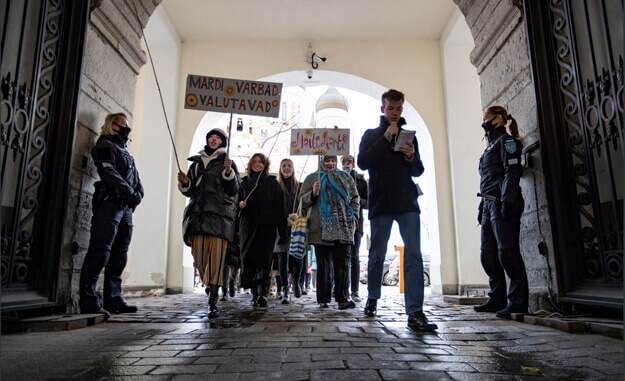
Children of Tallinn’s Old Town’s schools traditionally visit Riigikogu (Parlament) on Martinmas, where they were greeted by Henn Põlluaas, the Speaker of the Riigikogu. Photo by Postimees
Late autumn is the time when harvests conclude, the weather cools and the days grow shorter.
In Estonia, as in many northern countries, this season is associated with the visiting of departed souls and good luck rituals.
Halloween is one such holiday during this period, but Estonia has its own local variations: mardi- and kadripäev.
Origins
The end of September through Christmas is a time in many countries when souls visit the living.
This period coincides with the end of harvests and agricultural activity, as well as the darkest part of the year and the beginning of winter. It was believed that one had to please visiting souls to ensure protection for crops, sheep and cattle by not speaking or working on certain days, and most importantly, offering the souls food.
Two holidays occur during November in Estonia: Martinmas (mardipäev) on November 10th and St. Catherine’s Day (kadripäev) on November 25th.
On the eve before both holidays, children traditionally visited houses around the village singing, telling riddles and collecting sweets.
On Martinmas children were led by a mardi-father, dressed in dark clothing and made plenty of noise by playing instruments or banging pots.
Their arrival to houses was meant to bring harvest luck.
The procession was followed by a village party where goose was served for good luck.
On St. Catherine’s Day children were led by a kadri-mother and wore light coloured women’s clothing.
Kama, porridge, beans and peas were eaten along with homemade beer on this day.
Kadri, a common female name in Estonia, is also the guardian spirit of cattle, thus the holiday was meant to bring luck to cows and sheep through the winter.
Contemporary customs
Modern day Estonia is not the agricultural society it once was, but Martinmas and St. Catherine’s Day continue to be celebrated by young people, particularly in small towns and the countryside.
School children dress in dark colours on Martinmas and sing the mardilaul (Mart’s song) to be let in at the door and wear light colours and sing the kadrilaul (Kadri’s song) on St. Cathe-rine’s Day.
Echoes of the traditional way of life, connected to the seasons and harvests, can still be seen this November.
VES/visitestonia.com















